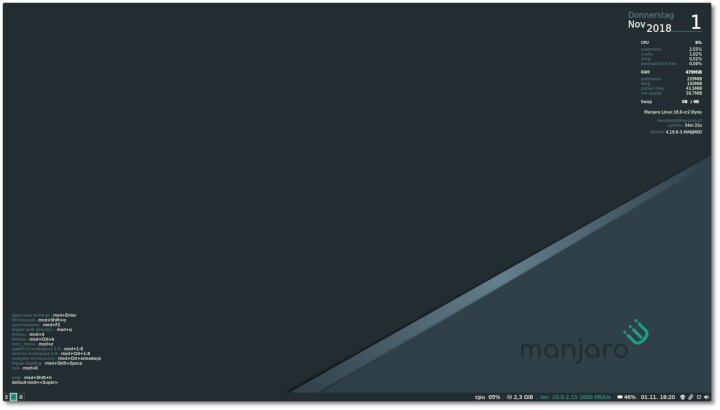Migrating To Manjaro i3
08 January 2019
Photo: Andy Crouch
Happy New Year!
The latter part of 2018 was so busy for me that I hardly got to write at all. This year I want to get back to some learning and playing with languages and frameworks. So the new year called for a new approach to my Linux environment.
After many years of using KDE, I switched to Gnome a few years ago but had become frustrated. Extensions are the only way to make it truly useful and they are flaky at best. Relying on your user base to create and maintain functionality that should be in the core code is wrong. Most of them break between major version upgrades. I struggled through the last 6 months with random crashes and resource issues. I was starting to look around and thinking of switching to Deepin or Cinnamon.
Around this time as well I was finding a few stability issues with Antergos. One of the now many Arch Linux spins. For a couple of VM’s I was using, I had switched to Manjaro Gnome edition. I found it to be rock solid in my limited usage and quite polished.
Around the end of 2018 I had a really interesting chat with a designer friend. We discussed how Linux is generally ugly. Out of the box, no environment can really consider itself a worthy contender against Windows or OSX. This is clearly the case as most environments provide a theming mechanism. Yes, I know the choice is good and it’s great that you can personalise your environment how you want. But, not one theme could compete with commercial design. We agreed that this could be one of the reasons desktop Linux has never reached the masses as it should have.
So having decided I was getting grumpy with Gnome and aghast with Antergos I decided to use some of my Christmas downtime to create a new environment. I decided I wanted it:
- Fast
- Beautiful
- Easily Reproducible
- Focused
So I have decided to move to Manjaro i3. This is a community spin of Manjaro with the i3 Window manager. i3 is a tiling window manager and not a full desktop environment. It is highly configurable and aimed at advanced users and developers. It provides a number of keyboard shortcuts to navigate and work with applications. The Manjaro i3 spin actually uses i3-gaps which is a fork with some additional functionality which can be read up on here.
i3 can be installed in Arch (or most distributions) easily. But the reason that I chose Manjaro’s spin was that it comes with a really nice configuration to start with. You can then use it to create your own configuration and set up.
I have been trying to clean up my dot files for a couple of years and always get so far and then just work with what I have. So this switch will result in sorting out all of my files and configurations. The aim is to create a single repo that I can clone on any image or machine and have my working environment up quickly. As I have written about before, now that I am a time poor family guy, having a good working environment is important. Hours customising and tweaking themes and settings are a thing of the past.
So the next few posts will be related to this switch and how I manage to create a good looking, fast and lightweight environment.
If you you have any tips for i3 worth sharing or want me to cover any specific area’s of using or configuring i3 then message me via twitter or email.
 Welcome to my site and blog. You can find out about me and read my thoughts on code and technology, start-ups and building things.
Welcome to my site and blog. You can find out about me and read my thoughts on code and technology, start-ups and building things.